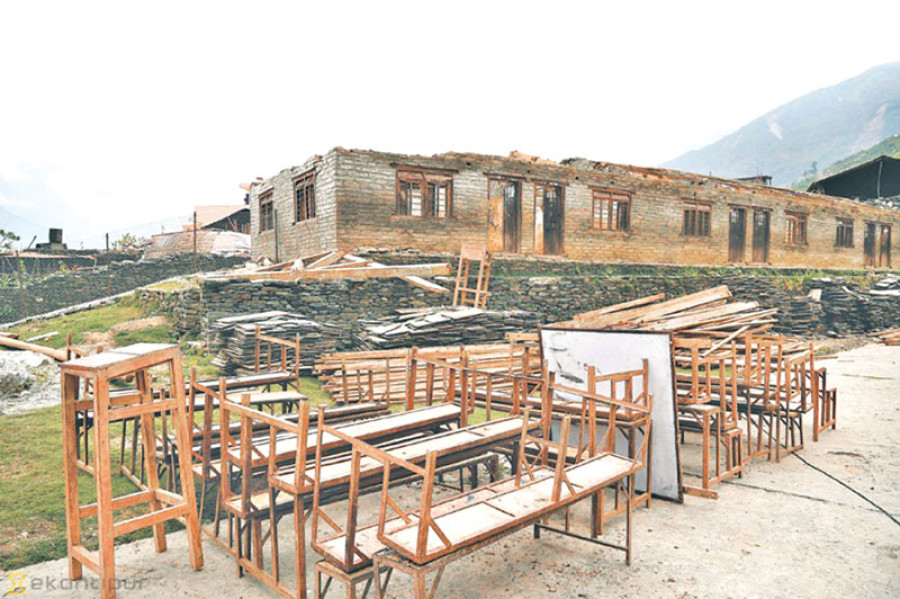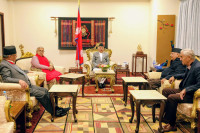Opinion
Safer schools
Children are still inside buildings not knowing when the roof would collapse
Prajjwal Kumar Dahal
Since we have arrived at the anniversary of the Gorkha Earthquake that hit the nation on April 25, 2015, it’s an opportune moment to look back and assess what has been done in terms of reconstruction and how. Talking specifically about the education sector, we were relatively fortunate that the earthquake struck on a Saturday and not on a weekday. In the spirit of the movement “Build Back Better”, we should reconstruct our schools with the capacity to withstand earthquakes of a similar or higher magnitude so as to ensure that they are safe for children. Unfortunately, government data show that not even a single school has been reconstructed.
The Department of Education (DoE) claims that a minimum of 5,000 school buildings should be constructed in 14 quake-affected districts. Among the 5,000 schools, the government has received pledged support from the Japan International Cooperation Agency (JICA) and the Asian Development Bank (ADB) for around 1,500 buildings. The DoE has reached a memorandum of understanding (MoU) with different INGOs for the construction of 600 buildings. Still, there is no fund for the construction of the remaining 2,900 school buildings.
Coordination woes
The DoE has accepted that due to the confusion between it and the Nepal Reconstruction Authority (NRA) on who would put in the budget for the construction of school buildings, no budget has been provisioned for the year. So it is likely that no construction will take place from the government side in the next one year as well, although the DOE has claimed that talks have been going on at the ministry level to rectify the situation. Lack of coordination among the government agencies seems to be creating a massive adverse impact on the educational sector.
There is little room for satisfaction even with the progress of construction supported by development partners. So far the tenders for only eight (five in Lalitpur and three in Kavre) schools have been published out of the 1,500 buildings supported by the JICA and ADB. Various INGOs are still in a dilemma on how to go about with the construction. The confusion stems from the fact that they have to sign MoUs at six levels before starting construction. This is not yet complete for any organisation as an MoU is also required with the NRA, which has not yet operationalised its functions. The NRA officials claim that they are coming up with a guideline for the mobilisation of INGOs. The content of the guideline, however, has not been disclosed. Therefore, there are doubts that the INGOs will be able to support the construction of 600 school buildings. The lengthy process that the Social Welfare Council takes to approve the projects strengthens the doubt.
It is natural for the government to take the lead and coordinate the reconstruction efforts but it seems to be failing to do so. There have been informal reports that construction has been taking place without the government’s approval. In many areas, communities are constructing schools with locally available resources without anti-seismic technologies. Some deaths have also been recorded due to improper construction of schools. There is a risk that the delay in the government’s response and poor coordination might result in the construction of substandard and unsafe structures.
Emergency phase still
Reconstruction of school infrastructures would clearly take quite a while. Would the academic session stop during that period? How long will the students have to study in the Temporary Learning Centres (TLCs)? The TLCs, which were constructed from bamboos in general, have survived the winter and now have to counter the monsoon. No discussion regarding this issue has started yet.
The emergency phase is now over and the recovery phase has started. But for the education sector, it is still the emergency phase. The children are still inside buildings marked in red not knowing when the roof would collapse. In such a scenario, one can imagine how much a child would be able to concentration on studies.
It is high time the government thought strategically and led the reconstruction efforts. Close coordination among the Ministry of Education, the DoE, the NRA and the Department of Urban Development and Building Construction is important for a successful reconstruction campaign. The reconstruction efforts need to be expedited, for which a fast-track approach should be adopted. The government cannot reconstruct schools on its own, so it has to smooth the path to reconstruction. It has to simplify the administrative processes. There should be no compromise on the quality of school infrastructures in the name of expediting the process. Community engagement and ownership should be a key aspect and core motivation behind the construction efforts at the local level.
Dahal is pursuing an MPhil in Development Studies at Kathmandu University




 7.12°C Kathmandu
7.12°C Kathmandu











